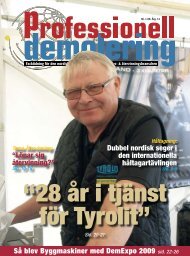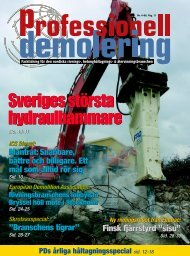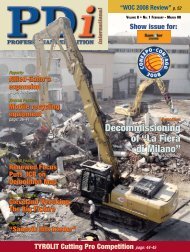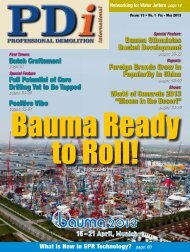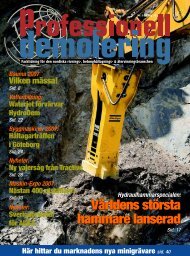Hitachi's Silver Lining - Pdworld.com
Hitachi's Silver Lining - Pdworld.com
Hitachi's Silver Lining - Pdworld.com
- No tags were found...
You also want an ePaper? Increase the reach of your titles
YUMPU automatically turns print PDFs into web optimized ePapers that Google loves.
Demolition - a focVolvo Construction Equipmentis a <strong>com</strong>pany with probablythe longest track-record in theconstruction machinery business.180 years of sustainabledevelopment is something tobe proud of. And for most ofthat time Volvo CE has stayedon top of their game. How abusiness enterprise can everbe that durable and <strong>com</strong>petitive?Bill Law, Volvo CE’sGlobal Director for ExternalCommunications, answeredthat and other questions atan interview with PDi’s AndreiBushmarin in Brussels.180-year tradition of innovation“With over 180 years of history Volvo CE is clearlya <strong>com</strong>pany in the industry that can state we’ve beenaround as long as anyone and have been part of theshaping of the whole industry. From our spiritual homein Eskilstuna to the global business we’ve be<strong>com</strong>e, the<strong>com</strong>pany has been instrumental in bringing some ofthe greatest innovations to the market. To mentionsome significant milestones one could say the creationof the wheel loader in the early 1950’s or the world’sfirst series manufactured articulated hauler in 1966Volvo has always been an innovator. In more moderntimes Volvo’s revolutionary care cab has set industrystandards for safety or the critically acclaimed V-Actengine aimed at reducing emissions.There was an announcement of a new Presidentand CEO at Volvo CE just recently. Who is the headof the <strong>com</strong>pany now?Pat Olney has taken over from Olof Persson sincethe beginning of May this year as Olof has taken up therole of CEO of the whole Volvo Group. Pat has manyyears experience in the industry and has been involvedin many parts of the business from the finance side tooverseeing the development of the global industrialsystem and developing the strategy that has been sosuccessful for Volvo CE since 2008. A Canadian bybirth, Pat has worked in many countries and since 2008was a member of the executive management team.Do you expect any changes to the <strong>com</strong>pany’sstrategy with the new man at the helm?As I said earlier Pat was one of the team who44 PDi • Issue 2 • May - June 2011was instrumental in developing our “fit for the futurestrategy” as such he’s clearly stated that his priority isto see the strategy fully and successfully implemented.As such you should not expect to see any radical changein direction. At the same time our business is alwayschanging as is our market and the strategy will beadapted and fine tuned to take account of the changeswe see in the world around us.Could you give us a snapshot of what Volvo istoday: its core businesses, employee number, andthe 2010 turnover?Volvo CE has grown dramatically since the late1990s. With a number of strategic acquisitions the<strong>com</strong>pany capitalized on its Swedish base to be<strong>com</strong>e oneof the leading providers of construction equipment andrelated services in the world. Building on its expansionin its core markets of Europe and North America Volvohas since gone really global. With the acquisition ofSamsung heavy industries in 2008 Volvo became thefirst major foreign investor in South Korea and at thesame time created a hub for its business in South EastAsia, subsequent acquisitions in China have seen Volvotake the number one spot in this huge market in theexcavator and wheel loader segment. Volvo today offersa full range of products and services in over 200countries, with production facilities in 14 locationsand more than 14,000 employees working hard tosatisfy our growing global customer base. In terms ofstatistics, despite the difficult conditions created bythe global financial crisis in 2008-09 Volvo bouncedback in 2010 with record product deliveries of over60,000 machines. It is not only sales that have seen apositive development, the last few years have also seenthe <strong>com</strong>pany grow profitably with operating marginsrunning at 10,8% which makes the <strong>com</strong>pany one ofthe most profitable in the industry.How many production facilities does Volvohave now?Volvo has production facilities in 14 countriesand is present in over 200 countries and territoriesaround the world.A focus on demolition and recyclingSince demolition and recycling are PDi magazine’smain subjects, would you describe brieflyVolvo’s demolition and recycling range?Demolition and recycling is an area that has longbeen in focus at Volvo Construction Equipment andtoday we have a <strong>com</strong>prehensive range of dedicatedmachines. For primary and secondary demolitionjobs, Volvo has six Standard Demolition Excavators,the EC210C, EC240C, EC290C, EC360C, EC460Cand EC700C. Added to this we have four ultra highreach (UHR) excavators, with booms from 21-32m andhigh visibility cabs. We also offer a range of demolitionattachments.What models of Volvo demolition excavators arethe most popular with the customers?As is often the case, the more specialized themachine, the lower volumes will be sold of them eachyear. This is the situation at Volvo CE, with the mostpopular machines being the general purpose 20 to 30tonne standard demolition excavators, which take alarge slice of total sales in the sector.What is, in your opinion, the reason behindtheir success?All models feature heavy duty fabrication, demolitionguarding, good visibility and the industryleading Care Cab. The value of the Volvo brand isalso important, which gives customers the assuranceof product innovation, high productivity, fuel efficiency– and critically in this sector – industry leadingsafety features.Any plans to extend the current demolition/




